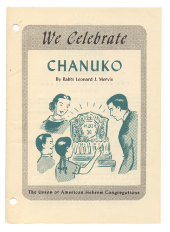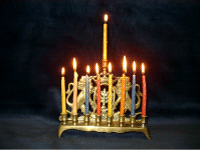| |
 American society became more child-centered as the birthrate climbed after World War II. Like other aspects of American life during this “baby boom” era, Jewish ritual observances in the home became more child-focused, as reflected in this 1953 publication. ID.2005.29.32 Gift of Judith E. Endelman and William D. Epstein in memory of Miriam Ruth Epstein
American society became more child-centered as the birthrate climbed after World War II. Like other aspects of American life during this “baby boom” era, Jewish ritual observances in the home became more child-focused, as reflected in this 1953 publication. ID.2005.29.32 Gift of Judith E. Endelman and William D. Epstein in memory of Miriam Ruth Epstein
 The section on Hanukkah in We Celebrate the Jewish Holidays includes traditional blessings and songs (in English and Hebrew), as well as suggestions for home decorations and games for parties. ID.2005.29.32 Gift of Judith E. Endelman and William D. Epstein in memory of Miriam Ruth Epstein
The section on Hanukkah in We Celebrate the Jewish Holidays includes traditional blessings and songs (in English and Hebrew), as well as suggestions for home decorations and games for parties. ID.2005.29.32 Gift of Judith E. Endelman and William D. Epstein in memory of Miriam Ruth Epstein
|
|
In America, Hanukkah continued to be celebrated in this modest way, if at all. After the Civil War—as the American Christmas began to transform itself into a holiday of decorations, parties, shopping, and gift-giving—American Jews were drawn to the bright lights and excitement of Christmas, which became a federal holiday in 1870.
Leading rabbis worried that, compared to the increasingly popular celebration of Christmas, Hanukkah lacked “romance” and allure. The campaign to revive and enhance Hanukkah began in the 1880s. Families were encouraged to create a festive atmosphere at home, to have Hanukkah parties, and to exchange gifts. By the 1920s, Hanukkah had begun to assert itself as a major Jewish domestic holiday.
Hanukkah reached its full flowering in the child-centered culture of post-World War II America. Beginning in the 1950s, not only did more families celebrate the holiday, the celebrations became more elaborate. Jewish organizations encouraged this with books and manuals to help families make the holiday more appealing (and discourage the celebration of Christmas). Families might exchange gifts for eight nights, light several menorahs, give parties, prepare special foods, and decorate their house.
--Judith E. Endelman
Director, Benson Ford Research Center
|
|
The Levi Family Menorah
James Levi grew up in Newton, Massachusetts, in the 1940s and early 1950s. His family’s Hanukkah celebration included lighting the menorah (candlestick). Each night (beginning with one candle for the first night, then two for the second, until all eight were lit), saying the blessings over the candles in English and Hebrew, giving presents to both children and parents each night, and playing dreidel for “gelt” (chocolate coins).
|
When James and his wife Constance Levi were raising their own family in Larchmont, New York, in the 1970s, the “matter of fact” observance of his childhood became a “bigger deal.” The Levis continued all of the traditions of his childhood with the addition of others. They lit several menorahs, rather than just one. (In some families, each member lights their own menorah). Then they would turn off the lights to watch the beauty of the lit candles. They also added additional prayers to the standard ones and enjoyed making latkes (potato pancakes), Hanukkah cookies, and other special foods.
|
 |

